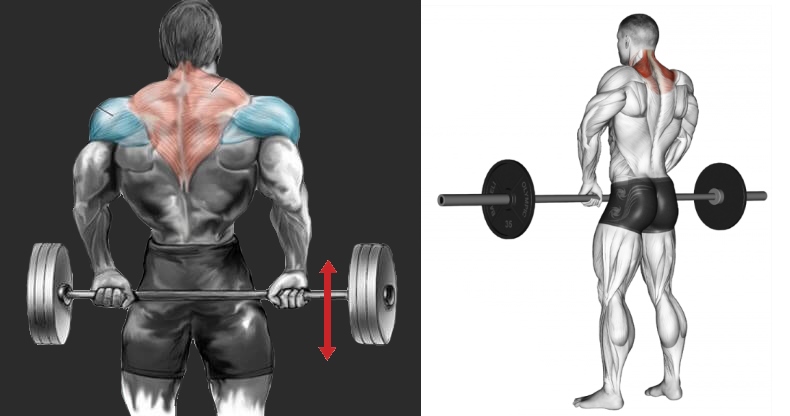Given that your traps are one of the largest muscles on your back and which can also scream power like no other feature on the upper body, you should aim on developing them as much as possible. The upper portion of the trapezius influences the overall roundness to a physiques frame, while the middle and lower portions contribute to back thickness. And if you’re serious about making your back stand out from the crowd, you want both width and thickness.
The primary function of the traps is to move or stabilize the scapulae (shoulder blades), which means they’re engaged most fully during shrugging movements, elevating the arms overhead and pulling the shoulders back.
The upper traps, which are responsible for raising the shoulders up, are seen from the front, and the middle and lower traps are seen from the back and they pull the scapulae together.
That being said, nothing is better for building a pair of massive traps than the combination of heavy weight and barbell shrugs! Read this article to learn which shrug is the best for you.
Shrugs come in many shapes and flavors, all of which can give you great results if you make sure your form is tight. If your form is bad, have in mind that performing shrugs incorrectly can increase your susceptibility to injuries such as rotator cuff tears, back and neck strains and muscle tears.
Front Barbell Shrugs vs Behind the Back Barbell Shrugs – muscles worked
Two basic types of shrugs are front barbell shrugs and behind-the-back barbell shrugs. Although they have gotten some bad rap lately, when performed correctly these two moves can help you build attention-grabbing traps faster than any other exercise, especially if coupled with heavy deadlifts. Still, because of the position of the bar, behind-the-back barbell shrugs will hit your traps in a different way than front barbell shrugs.
What muscles do behind the back shrugs work ?
More specifically, behind the back shrugs will engage more of your middle traps and help you add thickness, while front shrugs emphasize upper traps. Keeping the bar behind your back helps keep the shoulders pulled up and back, rather than rounded forward.
Both have negative sides, though: behind-the-back shrugs are performed in a rather uncomfortable position that limits the amount of weight you can work with, and doing front shrugs too often could lead to shoulder and neck issues.
Most people think that, unless your upper traps are overdeveloped due to excess stimulation through compound movements, you should be doing the standard, front barbell shrug more often, as it allows you to work with more weight and therefore make bigger gains in less time.
How to perform front barbell shrugs:

- As you stand up straight, grab a barbell and hold it in front of your thighs with an overhand grip.
- Space your hands and your feet about shoulder-width apart and slightly bend your knees.
- Keeping your arms extended, lift your shoulders up towards your ears – go as high as possible.
- Hold the peak contraction for a second, then slowly lower the bar back down.
But since both versions hit the muscles from a different angle and thereby stimulate different muscle fibers, you actually need them both in your program. There’s an even better way for blasting your traps that also guarantees a balanced trap development: supersetting front shrugs and behind the back shrugs! Do shrugs to the front for 15-20 reps, then do them behind the back for the same number of reps; repeat until you complete 4-5 supersets. Take 90 seconds of rest between each set.
How to perform behind the back barbell shrugs:

- Stand up straight with your feet at shoulder-width apart and hold a barbell with both hands behind your back, using a pronated grip slightly wider than shoulder width apart.
- Raise your shoulders up as far as possible while keeping your arms extended.
- Hold the peak contraction for a second, then slowly lower the bar back down.
- Refrain from rolling your shoulders.
Smith Machine Shrugs
Finally, don’t shy away from doing shrugs in the Smith machine once in a while – this variant allows you to go even heavier than usual and pull the bar higher on behind-the-back shrugs, thereby advancing your trap development, especially in the middle traps.
Here’s how:
- Set the bar height on the Smith machine to match around the middle of your thighs.
- Grab the bar with a pronated grip and hands at shoulder-width apart from each other.
- Fully extend your arms and lift the barbell up.
- Elevate the bar by raising your shoulders towards your ears.
- Hold the peak contraction for a moment, then slowly lower the bar back down.
Frankly, when anyone is not seeing good results with any type of shrugs, chances are they’re not doing them right – that’s how basic and important this exercise is. Eat clean, keep your form in check and just keep on shrugging!
